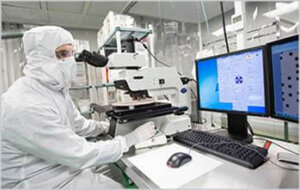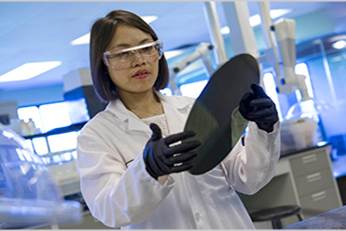 Last time I checked in with Kim Pollard, Technology Manager, Dynaloy, was a few years ago, when we talked about the importance of cleans for 3D ICs. Dynaloy, a subsidiary of Eastman Chemical Company, develops and creates chemistries specifically for the removal of photoresist, etch residues and other polymers. At the time, Pollard impressed upon me the concept that what we are really talking about is not just cleans, but surface engineering, or surface preparation, which has everything to do with end product reliability. For example, particles or residue on through silicon via (TSV) sidewalls post etch can lead to defects and voids in TSV fill. Additionally, adhesive residue left on an active wafer post debond can affect device reliability.
Last time I checked in with Kim Pollard, Technology Manager, Dynaloy, was a few years ago, when we talked about the importance of cleans for 3D ICs. Dynaloy, a subsidiary of Eastman Chemical Company, develops and creates chemistries specifically for the removal of photoresist, etch residues and other polymers. At the time, Pollard impressed upon me the concept that what we are really talking about is not just cleans, but surface engineering, or surface preparation, which has everything to do with end product reliability. For example, particles or residue on through silicon via (TSV) sidewalls post etch can lead to defects and voids in TSV fill. Additionally, adhesive residue left on an active wafer post debond can affect device reliability.
Pollard and the rest of the Dynaloy team have worked hard over the past two years to drive home the message that cleans are critical to advanced wafer level and 3D packaging applications. They’ve also begun to examine the importance of cleans to the reliability of devices targeting the Internet of Things (IoT). We spoke recently about these topics.
Do Cleans Affect Reliability of FOWLP and 3D ICs?
“With 3D applications, there are two camps,” explained Pollard, “Some that think cleaning can be done with current solutions and no further development is justified at this time while others are concerned about the needs versus traditional technologies. The reality is, cleaning is an issue for yield and reliability, whether we’re talking about fan-out wafer level packaging (FOWLP), 3D ICs, or 3D integrated devices. We are working to answer those questions and show how cleans affect reliability.”
Pollard illustrated her point using the Cu pillar/tin or tin-silver cap bump process. The tin may migrate to the Cu field metal during any or all of plating, descum, and resist strip processes. The next step after photoresist strip is Cu field metal etch. If the process isn’t well tuned, the tin that has migrated to the Cu field metal can act as a field mask, not allowing the Cu to be removed and resulting in device shorts. The problem is exacerbated by the fact that the tin is so thin, it’s transparent to standard optical inspection methods. Auger spectroscopy can prove the tin is there, but it isn’t commonly employed as a standard inspection tool. However, there’s no arguing that this can become a yield problem.
Cleans for the IoT
Pollard noted three main areas of focus at Dynaloy. First is to ensure a robust product offering that allows for IoT integration. As with many suppliers in the semiconductor industry, equipment and materials alike, the IoT is driving many of Dynaloy’s considerations.
“It’s a big market opportunity. It doesn’t matter if we’re talking about automotive applications, drone cameras, or medical devices. We’re looking for common and dissimilar threads which will help us apply our understanding to the situation and help us improve the success rates for all these people,” explained Pollard. “There are so many possibilities and arrays of devices being assembled. Ideally it would be one universal cleaning solution. The reality is, it requires consideration of a specialized cost structure, the cleaning challenge, compatibility, and specialized integration. We are trying to get a handle on it so we can provide good solid solutions.”
 Another area of focus for Pollard’s team involves a strategic initiative to improve the environmental health and safety of Dynaloy’s chemical formulations. “Our commitment to sustainability includes environmental stewardship, social responsibility and economic growth through the use of sustainable practices,” says Pollard. Her team is gathering information on different compounds, solvents and additives to develop formulation that improve user safety, reduce environmental waste, and improve recyclability of formulations. “We are actively trying to decrease the potential impact of our solutions on both the workers that use them and the environments they are used in.”
Another area of focus for Pollard’s team involves a strategic initiative to improve the environmental health and safety of Dynaloy’s chemical formulations. “Our commitment to sustainability includes environmental stewardship, social responsibility and economic growth through the use of sustainable practices,” says Pollard. Her team is gathering information on different compounds, solvents and additives to develop formulation that improve user safety, reduce environmental waste, and improve recyclability of formulations. “We are actively trying to decrease the potential impact of our solutions on both the workers that use them and the environments they are used in.”
“We really need to think through the processing for IoT applications,” noted Pollard. Diagnostic wearable devices, for example, need to be chemical-free so they don’t agitate the wearer. One aspect of reducing any issues, beyond selection of the material itself is ensuring that a remaining residue or final surface preparation does not cause irritation. Cleaning solutions are a good approach for modulating and controlling the surface.
Another example is in automotive electronics applications, where new sensor technologies are being added, and requiring other sensors to be relocated. Image sensors, in support of advanced driver assistance systems, may need to be located in the car dashboard, which may displace fuel sensors to an outside location like the engine block. The sensors will be required to operate over a wider range of conditions, including greater temperature ranges and increased vibrational backgrounds. When taken in consideration with the fact that an increased number of sensors will be needed, the only conclusion is that reliability must increase – or we will have to go and see our car mechanic much more often than we currently do! This creates the opportunity for improved chemistries. Cleaning is conducted many times during the manufacture of sensors. It is one area where an improvement could have a real impact to the end reliability due to the positive additive effect from each clean step. These types of considerations are driving needs for chemistries that have to meet different requirements than they did previously.
If orders in the AWLP and 3D space are any indication, people are getting the message. A few years ago, it seemed that clean chemistries were only considered as an after thought, Pollard said, but that’s changing, and people are no longer waiting until the end of process development to find a cleaning solution, but taking a more systematic approach to surface preparation. Pollard credits this in part to the advancement in failure analysis technologies like Auger spectroscopy, which helped to bring the importance of surface preparation to the forefront. For Dynaloy, things are definitely moving in the right direction. ~ F.v.T.





















